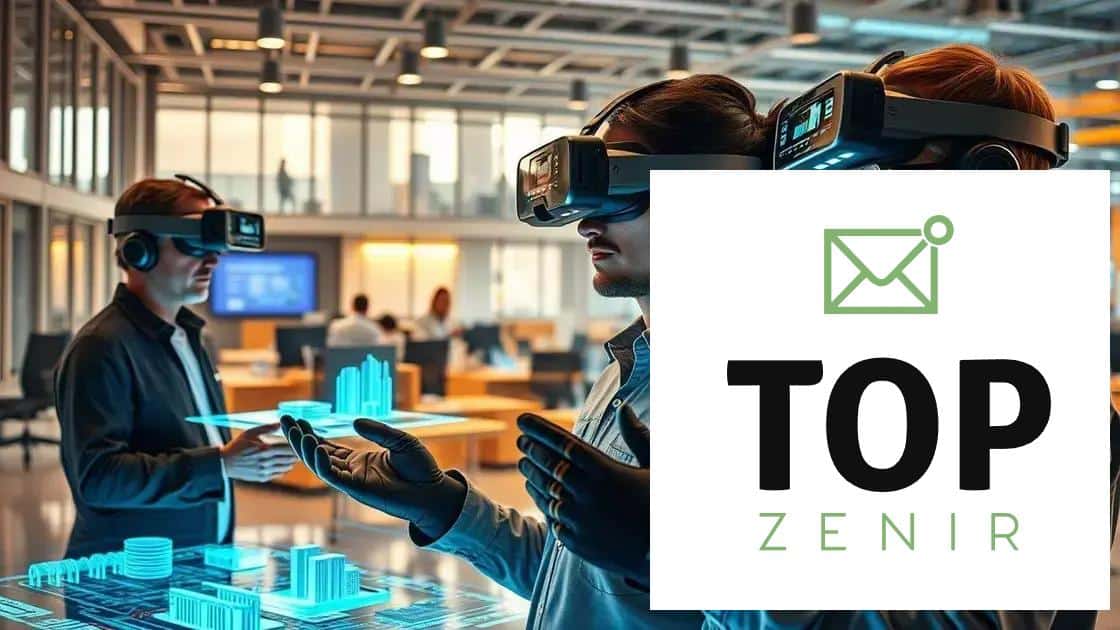Spatial computing gains traction across industries

Spatial computing integrates digital and physical worlds through technologies like AR and VR, enhancing customer experiences, increasing operational efficiency, and providing businesses with a competitive edge in various industries.
Spatial computing gains traction across industries, reshaping how businesses operate and interact with their environment.
Ever wondered how this technology could enhance your company’s efficiency? Let’s dive into its potential.
Understanding spatial computing and its significance
Understanding spatial computing is essential as this technology continues to evolve across different sectors. It refers to the integration of digital and physical elements, enabling users to interact with data in a three-dimensional space. This approach enhances not only user experiences but also operational efficiency.
What is Spatial Computing?
Spatial computing combines virtual reality (VR), augmented reality (AR), and mixed reality (MR) to create immersive experiences. By utilizing sensors, cameras, and software, spatial computing allows for interactions that feel natural and engaging.
Key Components of Spatial Computing
- Augmented Reality: The overlay of digital information onto the real world, enhancing how we perceive our environment.
- Virtual Reality: Complete immersion in a digital environment, often used in gaming and training simulations.
- Mixed Reality: Blending physical and digital worlds, allowing real-time interaction.
The significance of spatial computing can’t be overstated. It offers businesses innovative ways to approach problem-solving and customer engagement. For instance, virtual showrooms and interactive training programs transform traditional methods into dynamic experiences.
Moreover, industries like healthcare and education are utilizing spatial computing for training and simulations. Medical students can practice surgeries in a virtual environment, reducing the risk in real-life scenarios. Meanwhile, educators can create engaging learning experiences using AR and VR.
Impact on Various Sectors
Various sectors stand to gain remarkable advantages from adopting spatial computing:
- Retail: Enhanced customer experience through virtual try-ons and interactive displays.
- Healthcare: Improved training and remote consultations increasing accessibility.
- Manufacturing: Streamlined processes and better design assessments using 3D modeling.
As we explore further, it’s important to recognize that the journey of understanding spatial computing is just beginning. Companies that embrace this technology will likely lead the way in innovation and customer satisfaction.
Key industries adopting spatial computing

Key industries adopting spatial computing are rapidly changing how we view technology and its role in our lives. Various sectors are realizing the benefits of integrating this powerful technology into their operations. By examining these industries, we can see the transformative potential of spatial computing.
1. Healthcare
The healthcare industry is making significant strides with spatial computing. Medical professionals are utilizing augmented reality for surgical simulations and training. This technology allows doctors to practice procedures in a risk-free environment, enhancing their skills without endangering patients.
2. Retail
In retail, businesses are embracing spatial computing to create immersive shopping experiences. Virtual try-ons and interactive displays enhance customer engagement, allowing shoppers to visualize products before purchasing. This technology not only boosts sales but also improves customer satisfaction.
3. Education
Education is another industry where spatial computing is becoming essential. Schools and universities are incorporating augmented reality into their curricula to provide exciting learning opportunities. Students can explore historical events or scientific concepts in a 3D environment, making education more interactive and enjoyable.
4. Manufacturing
Manufacturing companies are leveraging spatial computing to optimize their processes. Using mixed reality, workers can visualize complex designs and workflows in real-time. This technology enables efficient training and reduces errors, ultimately improving productivity.
5. Real Estate
In the real estate sector, spatial computing allows for virtual tours of properties. Potential buyers can explore homes from the comfort of their own, making the buying process more convenient and engaging. This technology helps agents showcase properties effectively and reach a wider audience.
The adoption of spatial computing across these industries highlights its versatility and impact. As technology continues to advance, we can expect even more applications that will revolutionize how we work and interact with our environments.
Benefits of spatial computing for businesses
Benefits of spatial computing for businesses are numerous and impactful. This innovative technology is reshaping how companies operate and engage with their customers. By tapping into spatial computing, businesses can enhance productivity and customer satisfaction.
Enhanced Customer Experience
One main benefit of spatial computing is the ability to provide enhanced customer experiences. Through virtual and augmented reality, businesses can offer immersive interactions. Customers can visualize products in a 3D environment, helping them make informed purchasing decisions.
Improved Efficiency
Moreover, spatial computing significantly improves efficiency in various processes. Manufacturers, for instance, can use it to streamline operations. By implementing mixed reality applications, workers can visualize complex tasks, reducing the time spent on training and increasing overall productivity.
Cost Savings
Utilizing spatial computing can lead to substantial cost savings. Companies can reduce expenses related to physical prototypes and lengthy training sessions. Instead, they can create digital simulations that save both time and money. This shift allows businesses to allocate resources to other critical areas.
Competitive Advantage
In today’s competitive market, leveraging spatial computing can give businesses a significant edge. Those who adopt this technology early can attract more customers and stand out from the competition. Furthermore, the innovative nature of spatial computing signals to clients that a company is forward-thinking and invested in quality service.
Increased Collaboration
Spatial computing also fosters increased collaboration among teams. With tools that incorporate virtual environments, teams can work together in real-time, regardless of their physical locations. This connectivity enhances communication and idea-sharing, leading to more effective project outcomes.
In conclusion, the benefits of spatial computing for businesses extend beyond simple enhancements. By adopting this technology, companies can create a richer customer experience, improve efficiency, save costs, gain competitive advantages, and facilitate better collaboration.
Challenges in implementing spatial computing
Challenges in implementing spatial computing are significant and must be acknowledged by businesses considering this technology. While the benefits are apparent, several obstacles can hinder effective implementation. Understanding these challenges can help organizations prepare and adapt.
Technological Limitations
One of the main challenges is the technological barrier. Many businesses may lack access to the necessary hardware and software. High-quality devices capable of running spatial computing applications can be costly. Moreover, the technology is still evolving, which means that existing solutions might not be fully optimized.
Integration Issues
Integrating spatial computing into existing systems can also pose challenges. Companies might struggle to merge new technologies with legacy systems. This integration can require significant time and resources, which may deter some businesses. Ensuring all components work together seamlessly is essential for success.
Training and Skill Gaps
Another issue businesses face is the need for training. Employees must understand how to use spatial computing tools effectively. There often exists a skill gap where workers are unfamiliar with this technology. Providing proper training and support is crucial to maximizing the benefits of spatial computing.
Cost Considerations
The cost of adopting spatial computing can also be a substantial barrier. Companies need to consider not only the initial investment in hardware but also the ongoing costs associated with software updates and maintenance. Budget constraints may limit the potential for smaller businesses to implement these advanced technologies.
Data Security and Privacy
Additionally, the concerns surrounding data security and privacy cannot be overlooked. Spatial computing often involves collecting and managing vast amounts of data. Ensuring this data is secure is paramount to avoid breaches and maintain customer trust. Businesses need robust security measures in place to protect sensitive information.
By recognizing these challenges, organizations can develop strategies to address them effectively. Overcoming these obstacles is vital for businesses looking to leverage the benefits of spatial computing.
Future trends in spatial computing
Future trends in spatial computing are shaping the way we think about technology and its applications. As advancements continue to occur, several emerging trends are likely to redefine various industries. Understanding these trends can help businesses prepare for the future.
1. Growth of Augmented and Virtual Reality
The first trend is the rapid growth of augmented reality (AR) and virtual reality (VR) technologies. These tools are becoming more sophisticated and accessible. As hardware becomes less expensive, more businesses will integrate these technologies into their operations.
2. Enhanced Collaboration Tools
Another trend is the rise of enhanced collaboration tools that leverage spatial computing. These tools allow teams to work together in virtual spaces, regardless of location. This development promotes a new way of interacting and sharing ideas, making remote work even more effective.
3. Increased Use of Artificial Intelligence
Artificial intelligence will also play a crucial role in the future of spatial computing. AI can enhance the capabilities of spatial computing applications by offering smarter data analytics and personalized experiences. This integration can create more intuitive and interactive environments for users.
4. Focus on Data Security
As spatial computing grows, so does the focus on data security. With the rise of remote work and data sharing, ensuring the safety of sensitive information will be essential. Companies will be required to adopt advanced security measures to protect their data in virtual environments.
5. Expansion to New Industries
Additionally, spatial computing will likely expand into new industries like agriculture and real estate. In agriculture, spatial computing can optimize resource management and crop monitoring. In real estate, it can play a significant role in property visualization and virtual tours.
These trends indicate that spatial computing is on a path of significant growth and innovation. By staying informed and adapting to these changes, businesses can harness the full potential of this transformative technology.
FAQ – Frequently Asked Questions about Spatial Computing
What is spatial computing?
Spatial computing refers to the integration of digital information with the physical world, allowing users to interact with data in immersive ways, such as through augmented and virtual reality.
How can spatial computing benefit businesses?
Businesses can enhance customer experiences, improve operational efficiency, and gain a competitive edge by implementing spatial computing technologies.
What challenges do companies face when adopting spatial computing?
Some challenges include technological limitations, integration issues, training requirements, costs, and data security concerns.
What are the future trends in spatial computing?
Future trends include the growth of AR and VR technologies, enhanced collaboration tools, increased use of artificial intelligence, and expansion into new industries.





